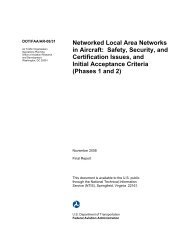Published Report (DOT/FAA/CT-94-36)
Published Report (DOT/FAA/CT-94-36)
Published Report (DOT/FAA/CT-94-36)
You also want an ePaper? Increase the reach of your titles
YUMPU automatically turns print PDFs into web optimized ePapers that Google loves.
lunder resulting in a TCV is highest when the blundering<br />
aircraft is slightly ahead (closer to the threshold) of the<br />
adjacent aircraft.<br />
For analytical purposes, an alignment l1window8l will be defined<br />
for blunders which would result in a TCV if the controllers did<br />
not intervene. These blunders were considered to be "at risk" of<br />
resulting in a TCV. The length of the window depends on the<br />
ratio of the speeds and the blunder angle, and it can be shown<br />
analytically to be independent of the runway separation. The<br />
speeds used in the simulation ranged from 120 kn to 227 kn. The<br />
120 kn was the slowest speed of a blundering aircraft, and the<br />
227 kn was the fastest speed of an evading aircraft.<br />
Assuming that either aircraft could be traveling at any speed<br />
between these two numbers, then the ratio of speeds ranged from<br />
120/227 = .53 to 227/120 = 1.89. Using the maximum speed ratio<br />
(1.89) with a blunder angle of 30 degrees, the maximum window<br />
length was 2279 ft. Therefore, the probability of an "at risk"<br />
blunder, assuming 3 nmi longitudinal separation between aircraft<br />
on the same approach, is given by:<br />
2279 = -125 = 1 Itat risk" WCB<br />
3 x 6076 8 WCB's<br />
Therefore, about one aligned approach occurs for every eight<br />
approaches executed.<br />
A review of the data indicated that a total of 186 WCB's were<br />
initiated when the blundering aircraft was in the alignment<br />
window. Of the "at risk" WCB's, two resulted in an actual TCV.<br />
Using a 99 percent confidence interval to compute the upper bound<br />
for the probability of a TCV given an llat risk" WCB, the upper<br />
bound would be 0.049, or:<br />
0.049 = 5 TCV's<br />
102 Itat risk" WCB's<br />
The NTSB would evaluate a mid-air collision as two accidents.<br />
Therefore, one TCV would equal two accidents:<br />
1 TCV<br />
2 ACC<br />
Finally, using the data cited above, the number of blunders which<br />
could occur in the operational environment, before the target<br />
probability of 1 fatal accident in 25 million approaches, can be<br />
calculated. The calculation is shown on the following page:<br />
42

















